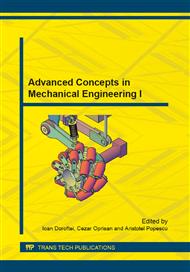p.339
p.345
p.351
p.357
p.365
p.371
p.377
p.381
p.389
About an Experimental Modeling of Steel Surfaces Wear in Injection of Plastic Composites with Short Glass Fibres
Abstract:
Consequences of the wear processes at screws and barrels of injection machines and extruders for processing of plastics reinforced with short glass fibers, arise after a longer time (10,000 cycles). Because of this they are working that through appropriate modeling attempts on the profits to be obtained in a short time as much information relating to both the mechanisms of wear and its size, so that the effect can be easily confuted in practice. Starting from the idea that the greatest pressure and velocity of composite melted is in the die nozzle, was an experimental nozzle with wear samples of sizes and weights which can be measured with precision as good. For a larger accuracy of measurements, we used a method for radiometric measuring, extremely accurate. Different nitriding steels have been studied as nitriding treatments, as well as some special steels and alloyed steels. Besides these, there have been preliminary attempts made to describe and checking corrosive action of thermoplasts on metals. This was another way of checking the wear testing of the samples semi-cylindrical wear samples, which served to simulate the wear of the top layer of the barrel and screw. The first results showed that wear increases depending on the increased pressure. One of the findings is that in similar conditions of injection, with the same content of glass fiber, polyamide 6.6 produces a wear greater than polycarbonate. It was also found that increasing the concentration of glass fibres increase the surfaces wear of barrels and screws.
Info:
Periodical:
Pages:
365-370
Citation:
Online since:
October 2014
Authors:
Price:
Сopyright:
© 2014 Trans Tech Publications Ltd. All Rights Reserved
Share:
Citation:


